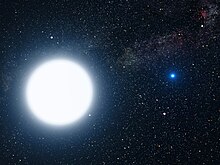Dog days
As dog days are commonly known in Europe , the hot days in summer, more concretely in the period from July 23 to August 23. The term dog days was originally associated with the heliacal rise of Sirius , which is no longer true today.
origin
It is named after the constellation Great Dog (Canis Major) . It takes 30 to 31 days from the rise of the constellation to its visibility as a whole, which is why the term “days of the big dog” (dog days) is derived from this. The star Muliphein represents the beginning of the head of the constellation, but is so faint that it can only be seen in full darkness. Sirius appears as the brightest star at dawn. With Aludra it worked out completely.
The time for the dog days ( Latin dies caniculares ) - 23 July to 23 August - originated in the Roman Empire . At the beginning of the Roman royal period , the visible heliacal rise of Sirius in Rome took place on July 26th; at the time of Julius Caesar in 46 BC On August 1st.
history
In the ancient Egyptian calendar , Sirius took on as the embodiment of the goddess Sopdet and as "Bringer of the Nile flood " in the third millennium BC. A special rank. The same event was later called heliacal rising by the Greeks , which means something like 'rising with the sun'.
The Greeks explained the connection between the return of Sirius and the days of the greatest summer heat using the following myth : The merging of sunlight with the "fire" of Sirius is the cause of the great heat. Arab astronomers even described the mirages , which appear particularly frequently in the shimmering summer heat, as "the saliva of the dog star dripping from the sky".
Today's meaning
The proper movement of the constellation Canis Major and the precession of the earth are responsible for the fact that the time of the dog days has shifted by about four weeks. In Germany , the heliacal rise of Sirius can only be observed from August 30th at the earliest and is therefore a sign of the approaching beginning of autumn . According to the old tradition , the hottest weeks of the year are still referred to as "dog days", also in other Indo-European languages:
- English dog days
- French la canicule
- Spanish la canícula , período canicular or días de las canículas , which generally means “heat, heat wave”
- Russian: kanikuly means "summer vacation".
Notes and individual references
- ^ Gregorian calendar , corresponds to August 3rd in the proleptic Julian calendar .
- ^ Gregorian calendar, corresponds to August 4th in the Julian calendar.
- ^ Dog days (of summer) at Merriam Webster


